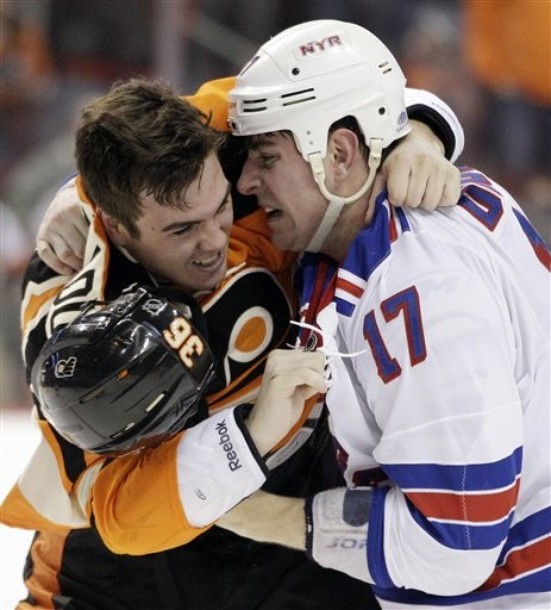
The Ontario Hockey League, one of several Canadian junior hockey leagues responsible for developing athletes into future NHL players, announced today that they are introducing a new rule that is intended to curtail the amount of fighting that occurs each season.
Per Mike Brehm of USAToday,
“If a player is assessed a fighting major for the 11th to 15th time during the regular season, he would receive an automatic two-game suspension for each fight.
If a player is deemed to be the instigator in any of the fights above the 10-game threshold, he would be assessed an automatic four-game suspension.
A 16th fighting major in the regular season would result in a two-game suspension and a $1,000 fine for the player’s team.
A fight would not count against a player for supplementary discipline reasons if his opponent were the instigator.”
Zac Rinaldo, who played for several OHL teams before joining the Adirondack Phantoms in 2010, already voiced his opinion on the subject via twitter: “That’s a joke! Bull$%^&.”
Rinaldo completed his rookie season with fifteen fights at the NHL level under his belt.
The discussion of whether fighting should remain in hockey usually comes up once a season. The rise in reported concussions, as well as continued research on the effects of long-term brain damage on sports players, has caused some of the sensitivity on the subject.
In this case, though, the rules being suggested by the OHL don’t appear to have much impact on the majority of their players.
Twenty-five players fought more than 10 times last season in the OHL, compared to 27 and 32 players in the prior two seasons. The number of “repeat” fighters in the league is trending down.
Rinaldo balked at the suggestion of putting a cap on fighting, but that’s likely because it was his doorway into an NHL contract.
The same goes for Tom Sestito and 2011 7th round draft pick Derek Mathers.
Sestito fought eight times during the 2011-12 season, but also bounced between leagues and lost games between suspensions and injuries. In his career, Sestito had more than ten fights in all three of his OHL seasons as well as three AHL seasons.
Mathers, who signed an entry level contract (ELC) with the Flyers earlier this year, is arguably the current heavyweight champion of the OHL. He finished last season with 22 fights, and nobody came close to his 27 fights in the 2010-11 season.
Had the OHL implemented this rule earlier, there’s a legitimate possibility that none of these three players would have been drafted or signed to an ELC (though Sestito put up respectable numbers in his final season in the OHL).
It’s worth noting that the rule doesn’t seem to suggest that fighting doesn’t belong in hockey, as much as staged fighting should go.
Wayne Simmonds serves as a good example of when fighting is appropriate. In addition to setting a career high in goals, Simmonds dropped the gloves ten times last season. While I don’t think I need to cite a third party to say “he handily won most of his fights,” Simmonds was voted winner of eight of those ten fights by a wide margin on Hockeyfights.com.
Ideally, Simmonds should serve as a template for a forward like Scott Laughton, drafted by the Flyers this past June. Laughton has been described as feisty with a very competitive edge, but he has fought just ten times over the last two OHL seasons.
Laughton has the potential to be an ideal third line center in the NHL. Honing his fighting skills at the junior level could help add an edge to his game, but it doesn’t need to be the only part of it.
It will take at least several seasons to observe if this rule has any ripple effect on how the NHL views the need for fighters. Considering the rule only affects one junior league, all it may do is shift the statistics of where organizations draft their fighters from.
It will be interesting, at the very least, to see how a player like Mathers responds this year.
A cap on fighting, that’s hilarious! I love hockey, but the fighting thing is just so goofy. Ban it outright like the other sports. Watching Olympic hockey on the larger sized rink with no fighting is so much more enjoyable than watching the NHL.